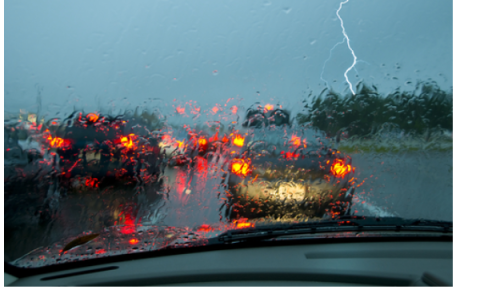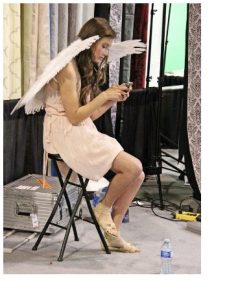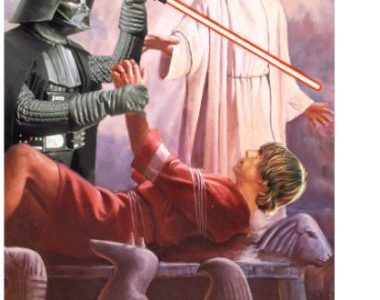I’ve already sinned against all that is holy in ELA education by arguing that similes and metaphors are the same #$@& thing and calling them by different names confuses everyone while distracting from what’s important – their purpose and impact.
I’m going to make things worse this time by talking about some common metaphors which aren’t always technically “metaphors.” Depending on how they’re used, they may become “symbolism,” “imagery,” or some other grand literary variation. As with the distinction between similes and metaphors, I get it – words mean things and there’s often great value in splitting hairs (an idiom that’s sort of a metaphor and definitely a cliché that kinda smacks of personification but is definitely not a colloquialism, unless it is). My focus, however, is on helping students notice cool stuff in what they read and listen to, then play with what it means and why it’s there.
We’ll clean up the technicalities later, time permitting.
A simile or metaphor compares two things which aren’t otherwise alike in order to emphasize one or more characteristics of the primary character or situation being described. Symbolism puts the metaphor in action literally as well as figuratively.
“Her brain was in a fog” is a metaphor.
“Perdita wandered through the fog, wondering if she were even getting close” is symbolism.
When a metaphor grows large enough to impact the actual setting of the story, it becomes symbolism. It still means the same thing; it’s just heavier and usually a bit more complex. Depending on the rest of the narrative, symbolism might also play into a story’s theme. When Harry Potter willingly “dies” to break the power of Voldemort, for example, he finds himself in a glowy white train station with his deceased mentor, Dumbledore. The train station is a rough metaphor for the afterlife, but Harry is actually there, at least in his own perceptions – so it’s also symbolism. The Harry Potter books repeatedly explore the theme of accepting our own mortality, so that’s in play as well.
But for now, we’re going to dial all of that way back and simply acknowledge some of the metaphors and symbolism which constitute the burgers, fries, and chicken strips on every literary devices menu. Many are no doubt obvious to you, but that doesn’t mean they’re immediately clear to our students.
Light and Dark
Light, the Sun, or any increase in brightness often suggests understanding or realization. This may come with warmth and happiness or a new opportunity to succeed, or it may be oppressive – uncomfortable levels of truth.
Darkness, night, or loss of vision due to other causes often indicates confusion or uncertainty which way to go. This can be an emotional low point (or outright despair) or lean more towards mystery, danger, or other difficulty.
Shadows and shade tend to represent many of the same things as darkness or blindness, but often carry hints of illicit behavior or sketchy choices – especially if the setting is urban or fantasy-based. The exception is shade when it provides relief from oppressive light or heat, in which case it suggests protection by a higher power (whether supernatural or not).
Seasons
In the real world, we’re largely confined by linear time. We move forward a day at a time, and the seasons do whatever the seasons do. In fiction, however, stuff happens whenever the author decides it should happen. If they go to the trouble to mention the time of year, it probably carries at least some literary value.
Winter is a time of symbolic death (or near death) – everything’s frozen and it’s dark more often. Winter can represent loneliness, withdrawal, or depression as well. There’s rarely forward motion in winter. (Even though Christmas and New Years both take place in the winter, they have their own symbolism.)
Spring is all about new birth, new life, new energy, and new possibilities. It’s a time of hope. This is probably the most commonly used season when it comes to metaphors and symbolism, and it’s almost always happy and yay.
Summer is often a time of freedom, life, excitement, and love. It’s the “young adult” time of year between the new birth and youth of spring and the winding down of fall. If the author focuses on heat or the intensity of the sun, however, summer can be oppressive for the same reason – it carries maturity and awareness we may not always want.
Fall is the most diverse of the seasons symbolically. On the one hand, it’s a period of decay as things transition from summer to winter. When representing the loss of youth or innocence, it may include a sense of nostalgia as well. Other times, it’s much harsher – serious loss or sickness. In your standard “hero’s quest,” the primary opposition to the goal is often established in the fall, things look increasingly hopeless in the winter, then solutions begin to appear in the spring. On the other hand, harvesting is often done in the fall, making this a time of abundance and gratitude (think Thanksgiving), and many people think it’s just the right amount of cold and dark to facilitate snuggling and hot chocolate and all that kinda stuff.
Weather
In real life, we may adjust our clothing or choice of activities based on what’s happening outside, but we have no control over the weather itself. Authors, on the other hand, are the creator-gods of their own little universes. The weather is whatever they say it is, so if they mention it, there’s usually a reason.
Sunny, warm, clear days suggest many of the same things as summer (above). They’re generally positive times, full of freedom and happiness and adventure. When coming after a storm, they suggest something closer to spring (above) – new life, you survived, time to clean up the mess and move forward. If the author instead chooses to focus on the oppressive heat, intense light, or drought, those metaphors take precedence.
Mist and fog suggest confusion or ambiguity. It’s difficult to see what’s ahead or think clearly, meaning it’s impossible to move forward with any certainty.
Cloudy hints of an uncertain future and warns of possible storms ahead. It’s not necessarily dark when it’s cloudy, but neither can you see the sun.
Storms imply turmoil, rage, or danger. Thunder and lightning hint at supernatural wrath (or at least a stern warning). Storms bring chaos or confusion, but with greater intensity or danger than fog or mist. They reflect external forces and internal struggles equally well.
Rain (or water in general) can mean any number of things. The most common uses involve rebirth or renewal, a combination of baptism (symbolizing death and resurrection as a new person) and spring showers bringing life to nature as winter fades. Water is cleansing, just like when you take a literal shower. If water isn’t falling from the sky, sometimes our protagonist falls into the water instead, or simply crosses a river – it’s still usually a “baptism” or major transition of some sort.
Occasionally rain will instead represent tears or sadness, especially when it’s not soaking our hero directly but instead running down a window or something less immersive. This is especially true in older pop music, where it’s something of a cliché.
Snow can go either way. On the one hand, snow literally covers everything with pure white flakes and makes it beautiful, suggesting purity, cleansing, or other refreshening. On the other, it’s the most winter thing there is, so it can just as easily suggest the opposite – death and burial. Either way, things rarely end in winter; an eventual spring is generally implied.
Doors, Windows, and Moving Vehicles
Doors allow us to move from one place to another, and all that implies. The standard “hero’s journey” begins with the protagonist leaving the familiar and crossing a threshold of some sort. It’s not always a literal door, and not every door is the beginning of a new hero’s journey, but doors of any sort in literature, poetry, songs, or art, are generally indicative of a major transition – usually by choice.
Windows allow us to see what’s outside while remaining confined (or safe?) inside, or – less often – the opportunity to gaze inside on something to which we’re denied actual entrance. They thus imply longing, perhaps a sense of being trapped or limited, but with aspirations clearly in play. When looking in, they suggest exclusion – perhaps a “man vs. society” dynamic. Window metaphors combine nicely with weather or seasonal imagery to create emotional complexity in characters or situations.
References to cars and driving create a sense of freedom and movement. The traditional role of trains means they more strongly imply progress, but modern transportation can serve that function as well. There’s a certain “solitary” vibe to most driving metaphors as well – automobiles isolate us at the same time as they propel us across great distances.
There are other “standard” metaphors – eyeglasses, birth or anything that takes nine months, dinners which look a lot like communion (the Last Supper), caves, etc. Once you’re thinking about them, they’re pretty much endless.
It’s worth restating that many uses of literary devices like those listed above are better categorized as symbolism, imagery, or some other technical classification. It’s also worth restating that for most practical purposes, I don’t care.
If a student notices that Hermione Granger’s name sounds like Hermes, a Greek deity able to travel between the worlds of humans and gods, much like Hermione is equally comfortable in the worlds of muggles or wizards, and they categorize this as a metaphor, I’m not going to scribble a long correction about how it’s closer to an allusion or simply a clever naming choice on the part of the author. I’m going to be thrilled they noticed and ask them what other names in the series they think might carry similar implications. I may confess that I’m not actually certain whether such things “count” as metaphors in the technical sense, but only as a side note – if it becomes the primary issue, I’ve failed on every level as both an educator and a human being.
We’ll save the examples for next time.


 I’m about to commit the gravest of blasphemies against ELA doctrine, so I might as well get it out of the way up front.
I’m about to commit the gravest of blasphemies against ELA doctrine, so I might as well get it out of the way up front.
 I’ve recently realized that I love musicals. Not all of them – not by a long shot – but enough that it’s definitely become a thing.
I’ve recently realized that I love musicals. Not all of them – not by a long shot – but enough that it’s definitely become a thing.